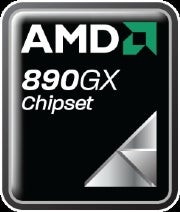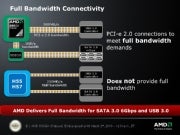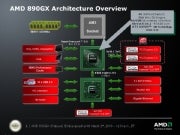AMD has announced its new 890GX chipset, the latest generation of its integrated graphics platform, and the first chipset to natively support SATA 6 Gb/s.
While Intel's Arrandale and Clarkdale integrated graphics bundle a GPU onto the CPU, AMD's solution is built right into the motherboard, and offers a relatively inexpensive platform with impressive potential for scalability.

For our tests, AMD provided the new Gigabyte 890GPA-UD3H, one of the first motherboards to support the new 890GX chipset. For comparison, we used a Gigabyte motherboard equipped with the 785G chipset. Introduced last August, the 785G chipset offers an integrated ATI Radeon HD 4200 graphics processor, versus the 890GX's Radeon HD 4290. Both graphics chips support DirectX 10.1, and the chief difference between them is their core clock: the Radeon HD 4200 runs at 500MHz, while the 890GX's Radeon HD 4290 runs at 700MHz.
We also used a pair of the recently launched 2.9 GHz AMD Athlon II X4 635 CPUs. Beyond the motherboards, our testbeds were identical: 4GB of RAM, 1TB hard drives, and optical drives for loading software.
The 890GX showed negligible improvement over the 785G chipset in our WorldBench 6 test suite, scoring a 110 over the 785G's 109. The 890GX began to pull away from the 785G during our graphics tests, but overall gaming performance is poor -- as expected, for an integrated graphics chip.
Running at 1024 x 768 resolution on medium settings, Unreal Tournament 3 saw an almost-playable 28.4 frames per second, versus the 785G's 21.4 frames per second. World in Conflict fared worse: at a resolution of 1366 x 768, medium settings, we saw 15 frames per second on the 890GX, and a paltry 10 frames per second on the 795GX.
Enthusiast level gaming wasn't much of an option, but high-definition media playback was promising. Playback was crisp and smooth, and CPU utilization wavered between a negligeble 10% and 13% while watching high-definition clips on both chipsets. The Radeon HD 4290 and HD 4200 both sport the Unified Video Decoder 2.0 technology, which supports MPEG-2 and H.264 decoding, as well as multi-monitor support, and Blu-ray playback with support for picture-in-picture functionality.
To our surprise, power consumption took a slight dip with the 890GX.Our meters hovered at 69.1 watts while our test system was idle, as opposed to the 785G's 77.5 watts. Under peak performance that difference evaporated -- 101.1 for the 890GX, and 100.2 for the 785G.
The integrated graphics may steal the limelight, but the 890GX chipset's defining characteristic is its updated southbridge -- dubbed the SB850. A Northbridge - Southbridge architecture is a standard feature of chipsets on a PC. The northbridge is responsible for interfacing with high-speed components, like the processor and memory. The southbridge controls lower-speed PC peripherals, such as hard drives, or USB ports.
The SB850 southbridge provides the aforementioned SATA 6 Gb/s support, a definite boon for digital packrats who enjoy speedy transfer rates of about 500MB/s. That bandwidth is made possible by AMD's 2 GB/s Alink Express III interface, which alleviates performance bottlenecks between the northbridge and the southbridge. And as AMD has so kindly pointed out, Intel's latest H55 and H57 chipsets deliver about half that bandwidth.
While final configurations will vary by motherboard model, the 890GX chipset offers a wide swath of connectivity options. It can support up to six SATA 6 Gb/s ports, 14 USB 2.0 ports, and two PCI Express 2.0 x16 slots -- these will run as x8 slots, should you have a pair of GPUs installed. There's no native USB 3.0 support however: our Gigabyte board offers USB 3.0 through an NEC host controller, and it'll be up to individual motherboard manufacturers to implement on their own.
Motherboard prices will also vary, but ASUS, MSI, and Gigabyte have released pricing estimates wavering between $130 and $180. Whether or not the chipset is worth the cost will depend upon an individual's needs. If you purchased a motherboard sporting the 785G chipset when it was announced, or have no interest in the performance benefits of SATA 6 Gb/s, you aren't likely to notice a difference in performance.
But the 890GX's greatest potential lies in its scalability. Motherboard-based integrated graphics allow system builders on a tight budget to piece together an inexpensive system, that's still suitable for high-definition media playback. As SATA 3.0 sees widespread adoption and prices fall, the 890GX's full 6Gb/s transfer rates will be the fastest game in town. And with a pair of PCI Express 2.0 graphics slots, you'll be able to add discrete graphics cards, expanding into Crossfire territory at your leisure. As an AM3 socket system, it'll support current CPUs, and compatibility is planned for AMD's upcoming Phenom II X6 processors, previously codenamed "Thuban."
If you're not interested in gaming, AMD's Dual Graphics technology will likely pique your interest. It combines their integrated graphics chips with their more inexpensive discrete cards, offering considerable performance gains, at bargain basement prices. While the preview is currently limited to the ATI Radeon 4200 and the $60 Radeon HD 5450 discrete graphics card, it will be of special interest to users looking for an inexpensive way to boost their performance.
All things considered, AMD's 890GX is readily expandable, sports tomorrow's tech, and is relatively cheap -- if you're in the market for a new PC, and want HD on the cheap, check back for more news on the 800-series.




